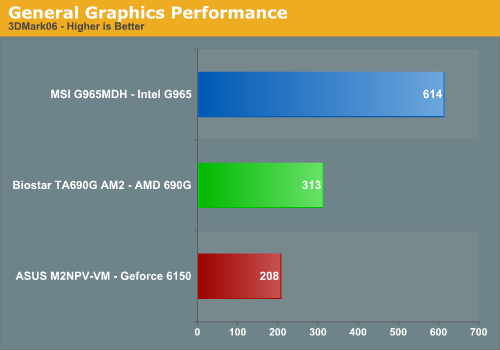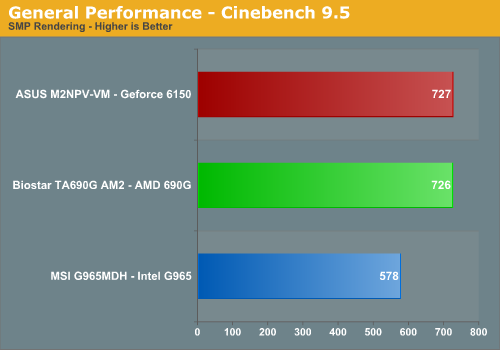Synthetic Graphics Performance
The 3DMark series of benchmarks developed and provided by Futuremark are among the most widely used tools for benchmark reporting and comparisons. Although the benchmarks are very useful for providing apple to apple comparisons across a broad array of GPU and CPU configurations they are not a substitute for actual application and gaming benchmarks. In this sense we consider the 3DMark benchmarks to be purely synthetic in nature but still valuable for providing consistent measurements of performance.

In our first test, the combination of the Intel Core 2 Duo and G965 makes for a great showing against the AM2 offerings. Okay, so we're being a bit sarcastic in that announcement as we consider these results to be anything but great. The Intel platform had no issues running the full 3DMark series but our AMD platforms could not complete the Shader Mark 3.0 tests. However, they exceeded the Intel platform scores in both the SM 2.0 and CPU tests. While the Intel platform passed the SM3.0 tests, this means little in actual game performance where the G965 failed to properly run games with SM3.0 capability.
General System Performance
The PCMark05 benchmark developed and provided by Futuremark was designed for determining overall system performance for the typical home computing user. This tool provides both system and component level benchmarking results utilizing subsets of real world applications or programs. This benchmark is useful for providing comparative results across a broad array of Graphics, CPU, Hard Disk, and Memory configurations along with multithreading results. In this sense we consider the PCMark benchmark to be both synthetic and real world in nature and it provides consistency in our benchmark results.

The margins are closer in the PCMark05 results with the 690G platform showing a minor advantage over the G965 and 6150 platforms. While this benchmark is designed around actual application usage, we will see if these results mirror our application testing.
Rendering Performance
We are using the Cinebench 9.5 benchmark as it tends to heavily stress the CPU subsystem while performing graphics modeling and rendering. Cinebench 9.5 features two different benchmarks with one test utilizing a single core and the second test showcasing the power of multiple cores in rendering the benchmark image. We utilize the standard multiple core benchmark demo and default settings.

The AM2 processors have always enjoyed an advantage in this test and the results continue to show the AM2 platform being dominant in this benchmark with a 26% advantage. The two AM2 platforms basically tie each other indicating CPU throughput is equal on either solution.
The 3DMark series of benchmarks developed and provided by Futuremark are among the most widely used tools for benchmark reporting and comparisons. Although the benchmarks are very useful for providing apple to apple comparisons across a broad array of GPU and CPU configurations they are not a substitute for actual application and gaming benchmarks. In this sense we consider the 3DMark benchmarks to be purely synthetic in nature but still valuable for providing consistent measurements of performance.

In our first test, the combination of the Intel Core 2 Duo and G965 makes for a great showing against the AM2 offerings. Okay, so we're being a bit sarcastic in that announcement as we consider these results to be anything but great. The Intel platform had no issues running the full 3DMark series but our AMD platforms could not complete the Shader Mark 3.0 tests. However, they exceeded the Intel platform scores in both the SM 2.0 and CPU tests. While the Intel platform passed the SM3.0 tests, this means little in actual game performance where the G965 failed to properly run games with SM3.0 capability.
General System Performance
The PCMark05 benchmark developed and provided by Futuremark was designed for determining overall system performance for the typical home computing user. This tool provides both system and component level benchmarking results utilizing subsets of real world applications or programs. This benchmark is useful for providing comparative results across a broad array of Graphics, CPU, Hard Disk, and Memory configurations along with multithreading results. In this sense we consider the PCMark benchmark to be both synthetic and real world in nature and it provides consistency in our benchmark results.

The margins are closer in the PCMark05 results with the 690G platform showing a minor advantage over the G965 and 6150 platforms. While this benchmark is designed around actual application usage, we will see if these results mirror our application testing.
Rendering Performance
We are using the Cinebench 9.5 benchmark as it tends to heavily stress the CPU subsystem while performing graphics modeling and rendering. Cinebench 9.5 features two different benchmarks with one test utilizing a single core and the second test showcasing the power of multiple cores in rendering the benchmark image. We utilize the standard multiple core benchmark demo and default settings.

The AM2 processors have always enjoyed an advantage in this test and the results continue to show the AM2 platform being dominant in this benchmark with a 26% advantage. The two AM2 platforms basically tie each other indicating CPU throughput is equal on either solution.










70 Comments
View All Comments
chucky2 - Wednesday, March 7, 2007 - link
BlingBlingArsch of the AnandTech forums linked to some pictures of the board, and there's one of the back panel I/O: http://img256.imageshack.us/img256/5498/board234cx...">http://img256.imageshack.us/img256/5498/board234cx...Looks like there's definitely no Firewire... :( :( :(
What are these manufacturers thinking (or rather not thinking) not including Firewire on this boards? These would be totally complete solutions, especially this Abit with the optical out it has, if they'd only have Firewire on them...
...and the expansion is so limited, putting in an add-in Firewire basically kills for TV tuner, capture, etc. additions.
Man...talk about something that's almost perfect that gets ruined by either a poor design decision or a poor bean counter decision... :(
Chuck
Myrandex - Wednesday, March 7, 2007 - link
"The 6150 performs okay considering the age of its core and we will see the new 6150SE and older 6100 chipset performing a few percent better overall but not enough to catch the 690G."How would the 6100 be a few percent better when it is clocked lower?
Renoir - Tuesday, March 6, 2007 - link
The review over at http://www.bit-tech.net/hardware/2007/03/02/amd_69...">Bit-tech.netsays the 690G supports dual-link DVI and confirmed as much by sending 2560x1600 over DVI to the dell 30incher. This review however says "Larger 30" flat panel monitors won't be able to run at native resolution" and the technology overview article says "The digital outputs use TMDS transmitters that run at 165MHz". What's the deal?Gary Key - Wednesday, March 7, 2007 - link
The 690G supports Dual-Link DVI. We had stated this on page two but not in a separate section. I will reword the 2D paragraph to make this clear. As for the resolution, I am using a Samsung 30" panel and the current Vista drivers limit me to 2048x1536. I have sent a board to Jarred who has the Dell 30" to test on it. AMD still confirms that 2048x1536 is the "current" max resolution although we know the hardware has 2560x1600 capability according to one of our sources.Renoir - Wednesday, March 7, 2007 - link
Hmmm something's not quite right it seems. Can't see why they were able to send 2560x1600 if you couldn't. Would definitely appreciate Jarred checking it on the dell although I'd be surprised if it was a monitor issue. Who knows without trying. Have asked bit-tech what os they were using to get it to work. An XP vs Vista issue perhaps? The related paragraph in the technology overview article mentions the TMDS's run at 165mhz which I understand is single-link? Have seen the 165mhz listed elsewhere for the 690G so am curious where this info comes from if the chipset is dual-link? Unless I've misunderstood something about "165mhz"?Gary Key - Wednesday, March 7, 2007 - link
The DVI spec transmits data using the transition minimized differential signaling (TMDS) protocol. The DVI spec calls for each DVI output to have at least one TMDS “link” consisting of three data channels (RGB) and one control channel. The maximum speed at which a single 10-bit TMDS link may operate at is 165MHz, offering 1.65Gbps of bandwidth. In real world terms, this means a single 10-bit TMDS link can drive a display at up to 1920 x 1200 (the actual maximum resolution can vary depending on the panel, spec is 1920x1080). For most displays that’s not a problem, but the 30” Displays have a native resolution of 2560 x 1600, which exceeds the bandwidth a single TMDS link can deliver. So what do you do? Remember that the DVI spec calls for at least one TMDS link, but each DVI port can support up to two TMDS links (the 690G has dual TDMS links), thus doubling the maximum bandwidth and enabling support for a 30" (if driver support is present) display or even some of the new 27" units that can run at 2048x1560.Renoir - Thursday, March 8, 2007 - link
Thanks for the reply Gary. That was precisely my understanding of the situation which is why I found the following quote from the technology overview article confusing "The digital outputs each use TMDS transmitters that run at 165MHz." This sentence didn't come across as saying the digital outputs had 2 TMDS "links" but rather just 1 running at 165mhz (hence single-link). Perhaps you could reword it to explain that each link runs at 165mhz but that there are actually 2 links in order to support the higher resolutions afforded by dual-link DVI. Don't mean to be picky just think this part could be a little clearer :-)As for the resolution cap at 2048x1536 you guys are experiencing the Bit-Tech guys have confirmed they got 2560x1600 working on XP and suggest your problem is an issue with the current vista drivers.
Gary Key - Thursday, March 8, 2007 - link
I have a new Vista driver as of today.Here are the specs -
DVI - Supports dual link up to 2560x1600.
HDMI - maximum resolution supported is 1920x1080 (using a HDMI-DVI cable
you can go up to 1920x1200)
VGA- Maximum resolution support depends on monitor refresh rates and aspect
ratios:
2048x1536 @ 85 Hz in 4:3 format
2560x1440 @ 75 Hz in 16:9 format
2728x1536 @ 60 Hz in 16:9 format
2456x1536 @ 60 Hz in 16:10 format
Hope that helps.
Renoir - Thursday, March 8, 2007 - link
That's cleared that up then (was merely a driver issue). Anyhow 2 questions1) Both digital outputs support HDCP but are on separate display controllers. Does that mean they have 2 built in cryptoroms (1 for each controller) given that separate cryptoroms are required for each controller/output? If they do have 2 then why only allow HDCP on one output at a time?
2) In a related point (upcoming mobile version of chipset) what connection do laptops use internally for their screens? The reason I ask is I'm interested in getting a laptop in future which supports both hdcp for the laptop screen but also via an external digital connection to a larger display.
jonman03 - Tuesday, March 6, 2007 - link
I know its onboard video and stuff, but a 3D Mark06 score of 313? They should be able to better than that, see who can get it into the 1000's first. Although unlikely, it'd be a nice alternative to buying a video card for a basic computing system.http://www.plugcomputers.com">Custom Gaming Computers